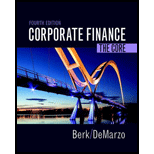
a)
To determine: Whether the bond is trading at par, premium, or discount.
Introduction:
A bond is a debt instrument with which the shareholder credits cash to an entity; this can be the government or an organization that scrounges finance for a distinct timeframe, at a predefined interest rate. Coupon rate is the expressed as an interest rate on a fixed income security, similar to a bond. It is also called as the interest rate that the bondholders get from their investment. It depends on the yield as on the day the bond is issued.
b)
To determine: The Yield to Maturity of the bond.
Introduction: A Yield to Maturity (YTM) is the
c.
To determine: The
Introduction: A bond is a debt instrument with which the shareholder credits cash to an entity; this can be the government or an organization that scrounges finance for a distinct timeframe, at a predefined interest rate. Coupon rate is expressed as an interest rate on a fixed income security, similar to a bond. It is also called as the interest rate that the bondholders get from their investment. It depends on the yield as on the day the bond is issued.
Want to see the full answer?
Check out a sample textbook solution
Chapter 6 Solutions
Corporate Finance: The Core (4th Edition) (Berk, DeMarzo & Harford, The Corporate Finance Series)
- You want to buy equipment that is available from 2 companies. The price of the equipment is the same for both companies. Silver Fashion would let you make quarterly payments of $14,930 for 8 years at an interest rate of 1.88 percent per quarter. Your first payment to Silver Fashion would be today. Valley Fashion would let you make X monthly payments of $73,323 at an interest rate of 0.70 percent per month. Your first payment to Valley Fashion would be in 1 month. What is X?arrow_forwardYou just bought a new car for $X. To pay for it, you took out a loan that requires regular monthly payments of $1,940 for 12 months and a special payment of $25,500 in 4 months. The interest rate on the loan is 1.06 percent per month and the first regular payment will be made in 1 month. What is X?arrow_forwardYou own 2 investments, A and B, which have a combined total value of $38,199. Investment A is expected to pay $85,300 in 6 years and has an expected return of 18.91 percent per year. Investment B is expected to pay $37,200 in X years and has an expected return of 18.10 percent. What is X?arrow_forward
- You own 2 investments, A and B, which have a combined total value of $51,280. Investment A is expected to pay $57,300 in 5 years and has an expected return of 13.13 percent per year. Investment B is expected to pay $X in 11 years and has an expected return of 12.73 percent per year. What is X?arrow_forwardEquipment is worth $225,243. It is expected to produce regular cash flows of $51,300 per year for 9 years and a special cash flow of $27,200 in 9 years. The cost of capital is X percent per year and the first regular cash flow will be produced in 1 year. What is X?arrow_forward2 years ago, you invested $13,500. In 2 years, you expect to have $20,472. If you expect to earn the same annual return after 2 years from today as the annual return implied from the past and expected values given in the problem, then in how many years from today do you expect to have $55,607?arrow_forward
- You plan to retire in 5 years with $650,489. You plan to withdraw $88,400 per year for 20 years. The expected return is X percent per year and the first regular withdrawal is expected in 6 years. What is X?arrow_forwardDon't used hand raiting and don't used Ai solutionarrow_forwardDon't used hand raiting and don't used Ai solutionarrow_forward
- Don't used hand raiting and don't used Ai solutionarrow_forwardEnds Feb 23 Explain in detail what is Risk as defined for financial assets and what is Beta? Also discuss in detail what is the Capital Asset Pricing Model (CAPM) and its purpose.arrow_forwardThe slope parameter ß1 measures the change in annual salary, in thousands of dollars, when return on equity increases by one percentage point. Because a higher roe is good for the company, we think ß1 > 0.The data set CEOSAL1 contains information on 209 CEOs for the year 1990; these data were obtained from Business Week (5/6/91). In this sample, the average annual salary is $1,281,120, with the smallest and largest being $223,000 and $14,822,000, respectively. The average return on equity for the years 1988, 1989, and 1990 is 17.18%, with the smallest and largest values being 0.5% and 56.3%, respectively.Using the data in CEOSAL1, the OLS regression line relating salary to roe is :arrow_forward
 Essentials Of InvestmentsFinanceISBN:9781260013924Author:Bodie, Zvi, Kane, Alex, MARCUS, Alan J.Publisher:Mcgraw-hill Education,
Essentials Of InvestmentsFinanceISBN:9781260013924Author:Bodie, Zvi, Kane, Alex, MARCUS, Alan J.Publisher:Mcgraw-hill Education,

 Foundations Of FinanceFinanceISBN:9780134897264Author:KEOWN, Arthur J., Martin, John D., PETTY, J. WilliamPublisher:Pearson,
Foundations Of FinanceFinanceISBN:9780134897264Author:KEOWN, Arthur J., Martin, John D., PETTY, J. WilliamPublisher:Pearson, Fundamentals of Financial Management (MindTap Cou...FinanceISBN:9781337395250Author:Eugene F. Brigham, Joel F. HoustonPublisher:Cengage Learning
Fundamentals of Financial Management (MindTap Cou...FinanceISBN:9781337395250Author:Eugene F. Brigham, Joel F. HoustonPublisher:Cengage Learning Corporate Finance (The Mcgraw-hill/Irwin Series i...FinanceISBN:9780077861759Author:Stephen A. Ross Franco Modigliani Professor of Financial Economics Professor, Randolph W Westerfield Robert R. Dockson Deans Chair in Bus. Admin., Jeffrey Jaffe, Bradford D Jordan ProfessorPublisher:McGraw-Hill Education
Corporate Finance (The Mcgraw-hill/Irwin Series i...FinanceISBN:9780077861759Author:Stephen A. Ross Franco Modigliani Professor of Financial Economics Professor, Randolph W Westerfield Robert R. Dockson Deans Chair in Bus. Admin., Jeffrey Jaffe, Bradford D Jordan ProfessorPublisher:McGraw-Hill Education





